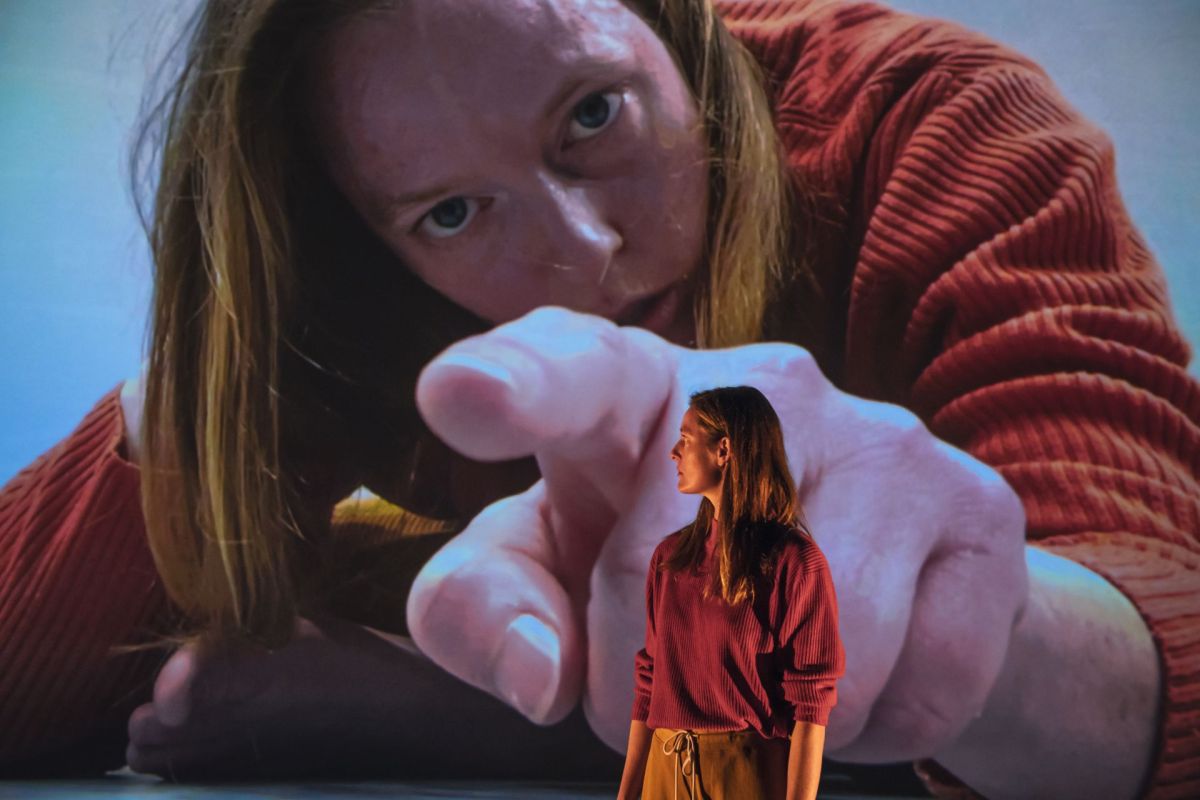Melbourne-based dancer/choreographer Sarah Aitken’s Make Your Life Count was first performed at Arts House in Melbourne in 2022. Since then it’s been restaged for Platform Arts in Geelong as well as exhibited as a purely digital work at various venues. The current season at PICA presents the work in its original form, juxtaposing live dance and movement with projected images.
Staging the show in the Central Galleries atrium space as the opening work of PICA’s ‘Performance in the Gallery’ season, Aiken uses shadow-projections and digital technology to explore scale and perspective, appearance and reality, and the evolving nature and role of the self in neoliberal societies (as well as the presentation and marketing of that “self” in the real world and online). Make Your Life Count is also an interrogation of the difference between “performance” and “exhibition” as modes of presentation, stage and screen as real or virtual “platforms” and perhaps even “theatre” and “gallery” as forms of space.
The first section of the work is an interaction between Aiken and a small window-sized (or perhaps portrait-sized) frame that she variously crouches inside or crawls through, illuminated by the blue light from a digital projector centrally placed on the floor at the front of the stage. The projector throws her shadow (and that of the frame) on a huge white screen upstage; the size of the shadows varies (but remains sharply defined) as Aiken moves herself and the frame closer to or further away from the projector or the screen.
There’s great beauty and elegance in the simplicity and clarity of the movement and image, but the cool blue emotional tone of the lighting and Andrew Wilson’s ambient sound design reinforce the sense of solitude and self-entrapment, and the seductive but disabling effect of “framing” and manipulating self and shadow (Hans Christian Andersen’s haunting story The Shadow springs to mind).
The next section features a verbal as well as physical/spatial interaction between Aiken and her own pre-recorded digital image, the latter now gigantically enlarged so that only parts of her body (initially her feet, and later her face, pressed to the floor) are contained within the frame of the screen.
Aiken engages in a somewhat cryptic and deadpan existential dialogue (text by Megan Payne and Aiken herself) with her Brobdingnagian counterpart about their respective modes of being; Aiken’s lines are spoken live, while the giant’s are pre-recorded and slowed down, its blind, shifting gaze occasionally intersecting with her own. The tone shifts to one of philosophical abstraction (the giant insists that it’s not a “god” but rather a kind of “landscape”) leavened by ungainly comedy, but an underlying sense of melancholy persists (reminiscent of the loneliness of giants in fairy tales).
The image zooms in and enlarges further, revealing a “landscape” of facial skin (and a single Cyclopean eye), and things become more surreal, as tiny images of Aiken begin to appear, multiply, move and dance on the “surface” of the image/skin. Meanwhile Aiken herself moves and dances in the space, her image captured by an iPhone camera inconspicuously placed at the edge of the stage, and then looped and projected onto the screen, so that it appears to generate and become part of the Lilliputian horde swarming across the giant’s face (it’s impossible to tell how much of this is live or pre-recorded, which adds to the sense of ontological uncertainty about what we’re seeing, or how much of it is “real” or “fake”).
Computer-generated images of what look like stars receding endlessly into the darkness are added to the visual mix, evoking Pascal’s vision of human insignificance in the face of ‘the eternal silence of infinite space’ in a Godless universe; the digital age, it seems, is likewise increasingly unmoored from any stable sense of self or underlying reality.
Read: Exhibition review: Art of The Brick, Melbourne Showgrounds
Meanwhile Aiken begins exiting and re-entering the space, bringing in and rearranging various differently sized and shaped white objects (plinths, cubes, A-frame boards), which act as smaller projection surfaces and interrupt the coherence and flow of the overall image. A sense of human agency and playfulness returns with this seemingly random choreography of objects and images, and the reality of the here-and-now, the body and the material world reasserts itself against the dominance of the virtual world onscreen.
The final video sequence involves time-lapse webcam footage of a gigantic corpse flower growing and flowering at Gustavus Adolphus College in Minnesota. In the footage, a sign on the wall bears the college motto: ‘Make Your Life Count’. Aitken now uses her iPhone camera to capture the words on the sign and project them onto the various surfaces now present in the space. It’s a playful mockery of online marketing, self-aggrandisement and surveillance capitalism – especially when the increasingly phallic-looking corpse flower begins to detumesce and topples awkwardly to the floor.
A closing coup de théâtre involves an act of visual and spatial sleight-of-hand, which it would be invidious to reveal; suffice to say that it trumps any form of digital simulation or trickery and demonstrates that the only escape from the vortex of the individual self lies, precisely, in the acknowledgment that in the real world, we are not alone.
Make Your Life Count
Perth Institute of Contemporary Arts (PICA)
Lead artist (Choreography, Video, Visual Design and Performance): Sarah Aiken
Performance: Claire Leske
Text: Megan Payne with Sarah Aiken
Lighting Design: Amelia Lever-Davidson
Sound Design: Andrew Wilson
Technical Designer: Daniel Arnott
Make Your Life Count will be performed until 20 April 2024.





